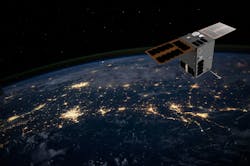Space quantum technologies are opening new horizons in sensing, timing and navigation, and secure communications. New approaches to space systems development and increasing launch accessibility are fueling accelerated translation of terrestrial quantum technologies for operation in orbit. The upcoming launches of several missions in the near future will build upon recent pioneering achievements—heralding a new era.
One of the ultimate goals is the large-scale satellite distribution of quantum entanglement for global quantum networking and other distributed quantum information processing tasks. Quantum communications will serve as the glue between quantum computers, sensors, clocks, and other networked quantum devices, analogous to how the internet connects the world today.
However, the standard method of transmitting light down optical fibers suffers from exponential absorption, which greatly limits the distance over which single-photon level quantum signals can be directly sent. Fixed links are also impractical for mobile platforms such as ships and planes, or remote areas.
Earth orbit provides a convenient vantage point for observation and communication. Light can travel unlimited distances through the vacuum of space, only spreading out due to diffraction, which allows satellite-mediated long-distance links.
Although clouds remain an issue, there is potential for technical and operational mitigations.
Quantum satellite links were first proposed in the 1990s, but it was the launch by China in 2016 of the Micius quantum satellite that ignited the field. Micius’ successes renewed international interest leading to a flurry of quantum space missions, including those in Canada, Singapore, across Europe, and the U.K.
The first deployed space quantum communication application will be satellite quantum key distribution (QKD), where satellites distribute encryption keys securely across the Earth. Current methods require the satellite to act as a “trusted node,” but the use of quantum entanglement or other advanced protocols can dispense with this need in the future.
Developing quantum technologies on the ground is difficult enough, but getting them to work in space introduces new challenges. Payloads have to survive the shock and vibration of launch, the vacuum and radiation environment of space, and contend with an extreme thermal environment.
Another challenge is bridging the gap between rapid quantum technology advancement with a traditionally conservative space engineering sector. Since 2009, the University of Strathclyde and the Centre for Quantum Technologies (National University of Singapore, NUS) have collaborated on using nanosatellites (satellites of mass 1 to 10 kg, specifically CubeSats) to accelerate the development of space quantum technologies with lower costs and a faster cadence. The first quantum correlated photon pair source in space was demonstrated on the NUS Galassia CubeSat launched in 2015, and the smallest satellite entangled photon source flew on the CQT CubeSat SpooQy-1 in 2019.
Several other CubeSat missions are scheduled for launch soon, including the Satellite Platform for Optical Quantum Communications (SPOQC) mission developed by the UK Quantum Communications Hub consortium (York, Bristol, Heriot-Watt, and Strathclyde universities, and RAL Space) that will demonstrate both discrete variable and continuous variable QKD.
Another CubeSat mission is OPS-SAT VOLT led by the Glasgow-based SME Craft Prospect Ltd, funded by the European Space Agency and the UK Space Agency. Craft Prospect, assisted by the Universities of Bristol and Strathclyde, also provides a QKD source for the Canadian small satellite (smallsat) mission QEYSSat (University of Waterloo). Other CubeSat missions include SpeQtre (UK-Singapore), SpeQtral-1 (Singapore), QUBE-1 & 2, and QUICK3 (Germany), that will demonstrate QKD and other photonic quantum technologies in space.
On a larger scale, China is developing a quantum satellite constellation—it launched the Jinan-1 smallsat in 2022 and is integrating SatQKD with terrestrial networks. The European Union and the European Space Agency will launch Eagle-1 to initiate the space segment of the European Quantum Communications Infrastructure (EuroQCI) with following missions planned, including SAGA, IRIS2, TeQuantS, and Caramuel.
Space quantum milestones also include the first Bose-Einstein condensate (BEC) in space on the MAIUS sub-orbital rocket, the first BEC in orbit on the International Space Station Cold Atom Laboratory (CAL), and the Cold Atom Clock Experiment in Space (CACES) on the Tiangong-2 space station. These pave the way for extremely sensitive quantum sensors to measure electromagnetic and gravitational fields, and ultraprecise clocks for next-gen global navigation satellite systems. Long baselines, gravitational potential differences, unlimited free-fall, and a low noise environment in space are attractive for quantum experiments probing new and fundamental physics.
Ultimately, space-enabled long-distance entanglement distribution can serve to network quantum devices to enhance their sensitivity, computational power, or operational abilities. Constellations equipped with quantum memories and repeaters will be able to create globe-spanning quantum links. And a deep space quantum link (NASA) could extend quantum communication and experiments to the Moon and beyond. The future for quantum technologies is looking up and onward.
FURTHER READING
J. S. Sidhu et al., IET Quantum Commun., 2, 182 (2021).
A. Belenchia et al., Phys. Rep., 951, 1 (2022).
